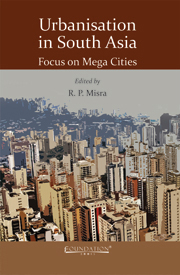Book contents
- Frontmatter
- Contents
- List of Figures
- List of Tables
- List of Contributors
- Introdution
- 1 South Asia: Land, People, and Economy
- 2 Historical Roots of South Asian Urbanisation
- 3 Mumbai: The Financial Capital of India
- 4 Delhi: Growing Problems of a Growing Megalopolis
- 5 Calcutta: The Emergence of Colonial Settlement into Megacity of the East
- 6 Chennai: A Rural Metropolis in Search of Modernity
- 7 Hyderabad: From the Feudal City to a Hi-Tech Metropolis
- 8 Bangalore: From Garden City to Silicon Valley of India
- 9 Karachi: The Commercial Capital of Pakistan
- 10 Lahore: The Cultural Heart of Pakistan
- 11 Kabul: A City in Perpetual Turmoil
- 12 Dhaka: A Mega City of Persistence and Change
- 13 Kathmandu: A City Where Tradition and Modernity Overwhelm Each Other
- 14 Thimphu: The City of Peace and Organic Development
- 15 Colombo: The Primate City of Sri Lanka
- 16 Male: Island Capital of an Island Nation
- 17 Beyond the Present: Vision of a New Urban Future
- Index
7 - Hyderabad: From the Feudal City to a Hi-Tech Metropolis
Published online by Cambridge University Press: 05 September 2013
- Frontmatter
- Contents
- List of Figures
- List of Tables
- List of Contributors
- Introdution
- 1 South Asia: Land, People, and Economy
- 2 Historical Roots of South Asian Urbanisation
- 3 Mumbai: The Financial Capital of India
- 4 Delhi: Growing Problems of a Growing Megalopolis
- 5 Calcutta: The Emergence of Colonial Settlement into Megacity of the East
- 6 Chennai: A Rural Metropolis in Search of Modernity
- 7 Hyderabad: From the Feudal City to a Hi-Tech Metropolis
- 8 Bangalore: From Garden City to Silicon Valley of India
- 9 Karachi: The Commercial Capital of Pakistan
- 10 Lahore: The Cultural Heart of Pakistan
- 11 Kabul: A City in Perpetual Turmoil
- 12 Dhaka: A Mega City of Persistence and Change
- 13 Kathmandu: A City Where Tradition and Modernity Overwhelm Each Other
- 14 Thimphu: The City of Peace and Organic Development
- 15 Colombo: The Primate City of Sri Lanka
- 16 Male: Island Capital of an Island Nation
- 17 Beyond the Present: Vision of a New Urban Future
- Index
Summary
Steeped deeply in tradition, yet at the same time moving fast to catch up with the emergent e-age, Hyderabad is an ‘eclectic mix of history and culture, a chaotic concoction of the medieval, the modern, and an uncouth adoption of post-modern’ urban value. Strategically located in South Central India, it is a city where north and south India meet to present a truly Indian culture and civilisation in all its manifestations. In Andhra Pradesh, the region of Telugu-speaking people, Hyderabad is an Urdu-speaking city with Hindus and Muslims, being in equal number. Together they constitute 95 per cent of the population of the city. The Old City, New City and Secunderabad, and the upcoming IT and technology hub, Cyberabad, represent the separation as well as blend of three generations: the medieval, the modern, and the post modern.
The city was founded by Muhammad Quli Qutb Shah of the Qutb Shahi dynasty, the ruling family of Golconda (11 km away), in 1591. The Shahs were earlier a feudatory of the Bahmani Sultanate, which was the first independent Islamic and Shiite Kingdom in South India. The Bahmanis ruled from Ahsanabad (Gulbarga in Karnataka) between 1347 and 1425. In 1425, the capital was shifted to Muhammadabad (Bidar in Karnataka). The sultanate reached its peak during the vizierate of Mahmud Gawan (1466-81). After ad 1500, it split into five sultanates (known as Deccan Sultanates): Ahmednagar, Berar, Bidar, Bijapur, and Golconda. Golconda had declared independence in 1512.
- Type
- Chapter
- Information
- Urbanisation in South AsiaFocus on Mega Cities, pp. 199 - 226Publisher: Foundation BooksPrint publication year: 2012



